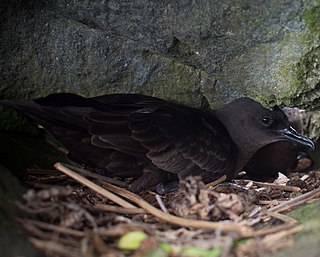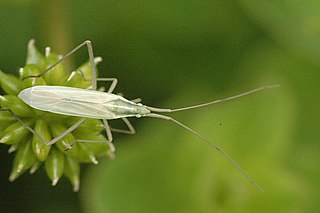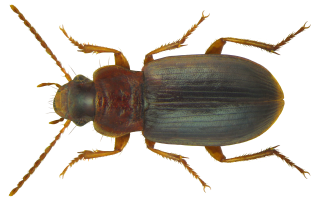
Dacrydium cupressinum, commonly known as rimu, is a large evergreen coniferous tree endemic to the forests of New Zealand. It is a member of the southern conifer group, the podocarps.

The common tern is a seabird in the family Laridae. This bird has a circumpolar distribution, its four subspecies breeding in temperate and subarctic regions of Europe, Asia and North America. It is strongly migratory, wintering in coastal tropical and subtropical regions. Breeding adults have light grey upperparts, white to very light grey underparts, a black cap, orange-red legs, and a narrow pointed bill. Depending on the subspecies, the bill may be mostly red with a black tip or all black. There are several similar species, including the partly sympatric Arctic tern, which can be separated on plumage details, leg and bill colour, or vocalisations.

Bulwer's petrel is a small petrel in the family Procellariidae that is found in tropical and subtropical regions of the Atlantic, Indian and Pacific Oceans. It is named after the English naturalist James Bulwer.

The muskrat or common muskrat is a medium-sized semiaquatic rodent native to North America and an introduced species in parts of Europe, Asia and South America.

Hemaris thysbe, the hummingbird clearwing, is a moth of the family Sphingidae (hawkmoths). Coloration varies between individuals, but typically the moth is olive green and burgundy on its back, and white or yellow and burgundy on the underside. Its wings are transparent with a reddish-brown border. It has light-colored legs, which combined with the lack of striping on the underside is diagnostic. Beating its wings rapidly, H. thysbe hovers to collect nectar from a variety of flowers. The combination of its appearance and its behavior commonly leads to it being confused with a hummingbird or bumblebee.

The green rosella or Tasmanian rosella is a species of parrot native to Tasmania and Bass Strait islands. It was described by the German naturalist Johann Friedrich Gmelin in 1788, and named on the mistaken assumption it came from New Caledonia. At 14.5 in (37 cm) long it is the largest species of the rosella genus, Platycercus. Two subspecies are recognised. The green rosella's underparts, neck and head are yellow, with a red band above the beak and violet-blue cheeks. The back is mostly black and green, and its long tail blue and green. The sexes have similar plumage, except the female has duller yellow plumage and more prominent red markings, as well as a smaller beak. Juvenile and immature birds have predominantly green plumage.

Trithemis annulata, commonly known as the violet dropwing, violet-marked darter, purple-blushed darter, or plum-coloured dropwing, is a species of dragonfly in the family Libellulidae. It is found in most of Africa, the Middle East, and southern Europe. These dragonflies are called dropwings because of their habit of immediately lowering their wings after landing on a perch. Males of this species are violet-red with red veins in the wings, while females are yellow and brown. Both sexes have red eyes.

Phyllocrania paradoxa, common name ghost mantis, is a small species of mantis from Africa remarkable for its leaf-like body. It is one of the three species in the genus Phyllocrania. It is known for its distinct and exclusive camouflaged appearance of a dry weathered leaf.

Alsophila aescularia, the March moth, is a species of moth of the family Geometridae. It is found throughout Europe and can be a pest of fruit trees.

Eriocrania semipurpurella is a moth of the family Eriocraniidae, found from Europe to Japan and in North America. It was first described by James Francis Stephens in 1835. The species closely resembles Eriocrania sangii and the larvae of both species mine the leaves of birch.

Eurydema oleracea is a species of shield bug in the family Pentatomidae and is commonly known as the rape bug, the crucifer shield bug, the cabbage bug or the brassica bug.

Ophonus is a ground beetle genus native to the Palearctic, the Near East, the Nearctic and North Africa. It contains the following species in the following subgenera:

Stigmella fulva is a moth of the family Nepticulidae. It is endemic to New Zealand and has been observed in the North Island around Mount Taranaki, in the South Island and at Stewart Island. The species' eggs are laid singly but a considerable number may be deposited on the upper surface of one leaf. The incubation period can last from a week to a month depending on climatic conditions. The larvae mine the leaves of their host plants which are all in the genus Olearia. Larvae have been recorded in all months except January, February and June. The cocoon is brown and spun amongst the leaf litter under its host plant. The pupal period has been shown to range from 21 days to 79 days, again depending on climatic conditions. Adults have been observed on the wing January until March and August to December. They are active in the sun about their larval food plant.

Notostira elongata is a species of bugs from a Miridae family, subfamily Mirinae. It is found everywhere in Europe except for Albania, Andorra, Bosnia and Herzegovina, various islands.
Adelphocoris rapidus, common names for which are rapid plant bug or superb plant bug, is a species of Hemiptera in the family Miridae, that can be found everywhere in the United States, and in the Peace–Athabasca Delta, Canada. The species are larger than other members of the family, and are either yellowish-black or orange-black coloured.

Stenocorus meridianus is a species of longhorn beetle in the Lepturinae subfamily that can be found anywhere in Europe, Caucasus, and Kazakhstan. They are 15–27 millimetres (0.59–1.06 in). The species have brown coloured legs, but can have either black (female) or brown (male) coloured prothorax. They occasionally feed on deciduous trees such as elm, maple, and oak. The species life cycle is from 2–3 years, with a flight time from May–July.
Ophonus puncticeps is a species of ruderal ground beetle native to the Palearctic realm, including Europe and the Near East.

Ophonus rufibarbis is a species of ground beetle that can be found everywhere in Europe and the Near East.

Proteroiulus fuscus is a species of millipede in the family Blaniulidae which can be found everywhere in Europe except for Albania, Andorra, Liechtenstein, Moldova, Monaco, Romania, San Marino, Vatican City, all states of former Yugoslavia and some European islands.
















